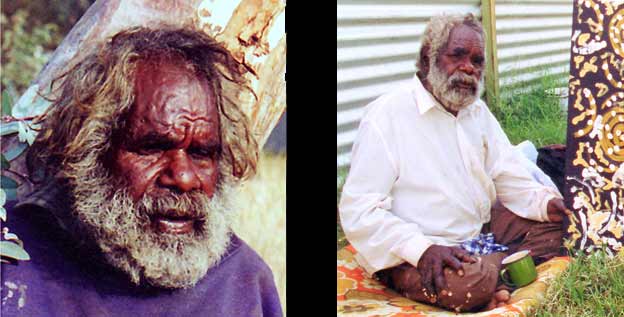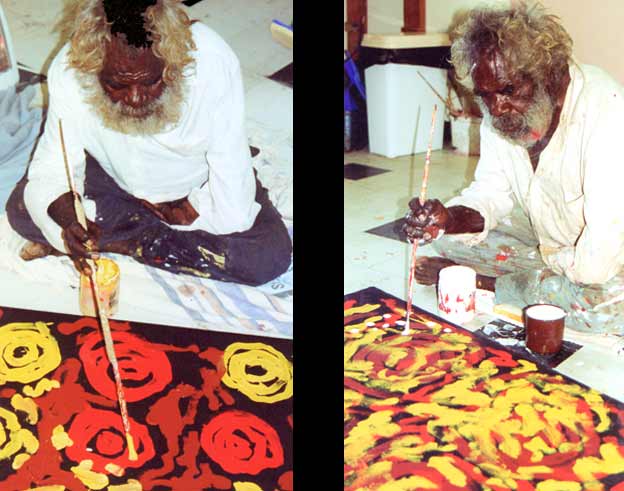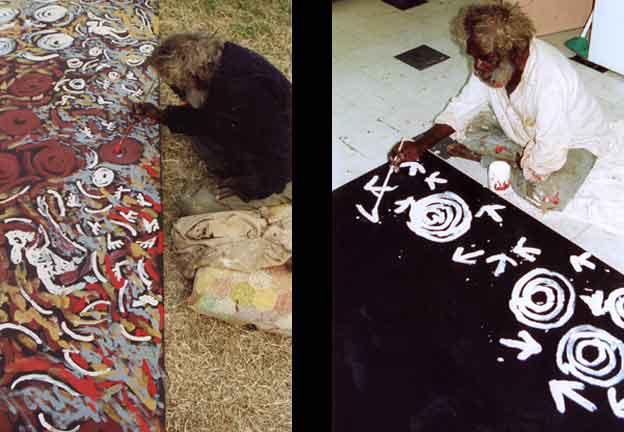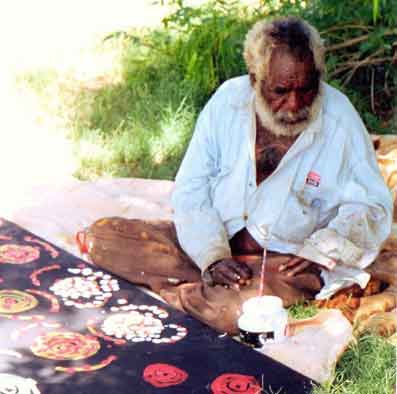Read more about: Johnny Warangkula Tjupurulla
SKIN NAME: URITJA/PINTUPI
DOB: c. 1925. DIED 2001
LANGUAGE: LURITJA/PINTUPI
REGION: PAPUNYA

Johnny Warangkula was a highly regarded Papunya artist who maintained a purist approach, using his paintings to tell Aboriginal stories in a highly expressive manner. Warangkula has been described as the finest abstract painter in Australia, and is credited for developing the over-dotting effect. Warangkula’s last body of work explores his deep connection with his birthplace at Tjakarri, using huge swirls of oranges, reds, yellows and whites to symbolise stories associated with ancestral dreaming.
He was born around 1925 at Minjilpirri, an area north west of Illipili and south of Lake Mackay. Close by is his major dreaming site Tjilkari. The son of mixed parents, his mother was of Luritja/ Warlpiri/Pintupi descent and his father Luritja/Warlpiri. Johnny was raised in a traditional manner, living an orthodox life style in the desert and never attending European schools. He is of the Luritja language group and was initiated into manhood and learned his dreamings during his family’s stay at a mission in Hermannsburg.
Johnny can recollect his first contact with Europeans, remembering his fearful response when witnessing an aircraft fly over his land as a young boy. His people believed the aeroplane to be a ‘marnu’ or devil. At a later date, his people came into contact with camels for the first time and again hid in fright as they recognised the beasts as being evil.
All of that is a far cry from the sophisticated auction rooms of Sotheby’s in Melbourne where, in July 1997, his painting ‘Water Dreaming at Kalipinypa’ changed hands for a record $206,000. When he sold the painting at Papunya 25 years previously he received just $150 and remembers this only in terms of the food which it bought at the time.
Interviewed in 1997 Johnny claimed, ‘I come from the bush. We dont know money’. From partial obscurity, ‘Johnnny W’, as he is affectionately known, became a figure to be reckoned with in the history of Australian art. Well before that time, however, the National Gallery of Australia had recognised his position in the scheme of Aboriginal art. In 1984, James Mollison, Director of the gallery claimed that their painting by Johnny W (the gallery’s first purchase of a western desert painting) was ‘the finest abstract art ever produced in this country’.
Johnny Warungkula Tjupurulla’s painting career began after a long turn at laboring, his efforts contributing to the development of roads, airstrips and settlements in areas such as Haasts Bluff, Mt Leibig, Yuendumu and Mt Wedge. In return for his work building roads, shoveling dirt and felling trees he was remunerated in the form of consumable goods, ‘tucker’ (as he calls it) - flour, tea, sugar, fresh vegetables and tobacco.
Before the bulk of the Haasts Bluff population was moved to Papunya in 1960, Johnny was selected along with Nosepeg Tjupurulla as Aboriginal representative to meet the Queen. After settling in Papunya, Johnny served on the Papunya Council with Mick Namarari, Limpi Tjapangati and Kingsley Tjungarrayi.
Geoffrey Bardon’s arrival at Papunya inspired the community to begin using western art materials. Johnny rapidly developed a distinctive style of his own which came to be known as ‘overdotting’. He uses several layers of dots to depict his dreamings, which consist of Water, Fire, Yam and Egret stories. There are also stories from Nyilppi and Nyalpilala that are his father’s Dreamings. Geoffrey Bardon labeled this stylistic layering effect as ‘tremulous illusion’ and in his book, Papunya Tula Art of the Western Desert, Bardon fondly recollects images of Johnny painting with an “intense level of intuitive concentration”.
From the very beginning at Papunya, Johnny has always adhered to the idea that his paintings are stories - Aboriginal stories. He has never allowed any infiltration of European influence and rarely used literal depictions of objects. Geoff Bardon advised the ‘painting mob’, of which Johnny was an important member, to paint in an Aboriginal way using Aboriginal signs and symbols that one might have found in body paint, tjuringa or sand paintings. Because of this ‘purity’ his works retain an integrity which places them among the most significant productions from the seminal art site that was Papunya.
Bardon pointed out that Johnny’s paintings ‘can be measured on a scale of modern aesthetic’. And as if to qualify that remark, Bardon further offered the idea that the artist used ‘caligraphic line with almost Baroque excitement’. A very insightful observation which still holds true, particularly in regards to the very ‘late’ and hugely energetic works of the late 1990’s. One of the great characteristics of the Baroque style, dominant in the seventeenth century, was the energy, rhythm and theatricality with which stories (usually Christian stories) were told. Johnny’s style was described this way:
Tight organization of bands and lines, hatching and dot embellishment give his work a powerful, energetic visual strength. He used convoluted spiral symbols for people, and animal tracks and distorted figures as illustrations of ceremony - not in a formal way but intuitively.
In early 1997, Michael Hollow made a great effort to revive Johnny's painting career and commissioned him to do a series of small works. From this series Johnny began a new phase in his distinguished painting career and developed this new direction with other galleries and dealers over the next few years. This series, and his final one, includes a range of small to very large dynamic, powerful paintings in pure red, blacks with white, yellow and ochre highlights. Each of the works features the established imagery of Johnny’s Dreamings overpainted to hide the secret and sacred elements. These works evolved slowly over an eighteen month period during which time the artist displayed once more his mastery of this unique form of art and storytelling. These important late works were made despite failing eyesight and poor health.
It may seem ludicrous to draw parallels between this Aboriginal painting master and Monet in their corresponding last years. However one cannot help noticing those similarities. Further, Johnny’s technique and brushwork bear an eerie resemblance to the techniques invented and employed by Monet in his late waterlilly paintings at Giverny. This may only prove that the mark-making we call art is a basic expression of the human spirit as one mind strives to communicate with another in visual terms. The Frenchman Monet was inspired by his Japanese watergarden - Warungkula by his birthright - his ancient dreamings.
From 1999 Johnny painted with a new-found freedom, both in expression and in painting technique. Where he was once known for his delicate and soft white dotting, he attacked the canvas to tell his stories with great gusto. He jabbed large dots on to the surface and produced roundels and symbols for weapons with great sweeps of his arm and the brush. Red. Black. White.
Had he painted in France during the 1950’s he would have been labeled a ‘Taschist’. The audience who saw his paintings at the United Nations Building seemed generally to agree that Johnny was indeed a significant artist who in some sense retained an authenticity and timeless importance in his work that some of the younger painters were yet to achieve. All great painters, past and present, seem to have an additional level in their work which may defy description. This elusive quality is sometimes born of the synthesis achieved between colour, form, texture and meaning. When viewing paintings by Johnny Warangkula Tjupurulla we find ourselves in a position where the recognition of another elemental level is tantalisingly close and for a lucky few the spirit is moved beyond words. In the presence of great visual art, the employment of everyday language can become a futile and unproductive gesture.

Collections:
Art Gallery of NSW
Queensland Art Gallery
National Gallery of Victoria
Art Gallery of Western Australia
Art Gallery of South Australia,
National Museum of Australia Canberra
National Gallery of Australia Canberra
Orange Regional Gallery
Alice Springs Law Courts
Museum & Art Gallery of the Northern Territory Darwin
Flinders University Art Museum
South Australian Museum
Holmes aCourt Collection
What they say about Johnny 'W'
“ Johnny was a painter’s painter. He used gesture, line and interval to create pictorial illusions that stand for the environment. His impetuous dots evoke vegetation and his lines the subtle topography of desert sandhills.”
- John Kean in Vivian Johnson (ed.) Papunya Painting p.7
“Master of visual effects created by overlaying of patterns of dots.”
- Wally Caruana, Aboriginal Art p.112
“…religiously ordained connection between the artist, ancestors and the land.”
- Wally Caruana , Aboriginal Art p.112
“…masterpieces of three-dimensional illusion”
- Judith Ryan, curator at the National Gallery of Victoria“
"The finest abstract art ever produced in this country."
- James Mollison, the Director of the Australian National Gallery in Victoria
"…modest but exquisitely confident”
- Geoffrey Bardon

DREAMINGS PAINTED BY JOHNNY WARANGKULA:
In Johnny Walangkura’s work there are two recurring Dreamtime stories, the “Tjakarri” Fire Dreaming and the Water Dreaming at Kalipimpa. Johnny was the custodian of these two ancient creation stories and it is his cultural responsibility that they continue to be passed down through oral exchange, initiation and ceremony.
His final body of work, several of which are available from Kate Owen Gallery, frequently depict a chapter in the Fire or Water Dreaming or the associated ceremonies. Although Johnny completed these works as an old man with diminished health, these stories were still strong and clear in his mind and this passion and wisdom is clearly visible in the paintings.
Water Dreaming at Kalipimpa
Kalipimpa is a water dreaming site some 500km north west of Alice Springs by road, track and finally, bush travel. Although the Pintubi had access to the water, it is on the eastern edge of their country and the traditional owners describe themselves as Mudoodjarra; they see themselves as a distinct entity, but have strong ties with the Kaukatjs to the south east and friendly associations with the Pintubi.
This place is the home of the ancestral rainstorm from which all the rain that falls in the desert is derived. The Tingari men who visit this place paint up for and take part in a ritual fight that is designed to relieve tensions and settle personal grievances.
Winpa the lightning ancestor is also associated with this place. In the Dreamtime (Creation period) a great storm erupted here. Whirlwinds lifted the dust in spirals and then great columns of dust were raised by the winds. Heavy rain fell as the rain clouds massed and there was much lightning. The downpour, as with present-day storms, was so heavy that soon the water was flowing along the ground, lifting leaves, logs and other debris. Very deep and permanent rock-holes were formed and as it flowed, the water was unimpeded by the debris and other objects in its path. The water flowed into the waterholes, rock pools and soakages, represented in many of the paintings by roundel concentric circles.
“Tjakarri” Fire Dreaming
These paintings depict the sacred fire site of Tjakarri, where the spirit of the Pangkalang Man resides. Sometimes a figure represents Tjampitjinpa, the old gray haired fire maker from Tjakarri. He is a giant cave man rather than a human being, and is shown with spears, nulla nullas, and boomerangs. The narrative describes this man as rama rama, ‘mad one’. He is seen fighting with another brother, hurling weapons at him, and when they prove to be ineffective he incants a magical fire from within the ground. A group of pynan nanya come up (Tingari men, Wallaby people) and see that this mad man has gone out into the fire. They follow his footprints left behind as he tried to escape the fire, they find him badly burnt. They manage to revive him and he is still out there till this day causing great fear to those who trespass on this site, especially after dark. The coloured roundels represent the other sacred sites around Tjakarri. All the white circles are body paint, while the other various white arches are killer and hunting boomerangs and spears. The red lines are the volcanic flames of the Dreamtime bushfire.

JOHNNY WARANGKULA'S LATE WORKS IN SYDNEY
Posted by Jeremy Eccles | 07.05.10 in review of our Johnny W solo exhibition.
Gallery: Kate Owen Gallery & Studio
Dates: 06.05.10 : 30.05.10
Johnnny Warangkula Tjupurulla (1918 - 2001) was one of the outstanding artists in the Aboriginal art movement. Warangkula was born around 1925 at Mintjilpirri, south of Lake Mackay. Close by is his major dreaming site Tjilkari. His mother was of Luritja/ Warlpiri/Pintupi descent and his father Luritja/Warlpiri. Johnny was raised in a traditional nomadic lifestyle in the desert, was initiated and learned his Dreamings.
Johnny could remember his first contact with Europeans, recalling his fearful response when seeing an aircraft fly over his land as a young boy. His people believed it to be a 'mamu' or devil. At a later date, his people came into contact with camels for the first time and again hid in fright as they decided the beasts were evil.
All of that is a far cry from the auction rooms of Sotheby's in Melbourne where, in July 1997, his painting 'Water Dreaming at Kalipinypa' changed hands for a then-record $206,000. When he sold the painting at Papunya 25 years previously he received just $150 and remembers this only in terms of the food which it bought at the time. Later, in June 2000, just before he died, that same work would be sold again for $486,500. It's often claimed as one of the main reasons for the introduction of Resale Royalties for artists by the current government – starting June 9th.
Well before that time, however, the National Gallery of Australia had recognised his position in the history in the history of art. In 1984, Director James Mollison claimed that their painting by Johnny W (the Gallery's first purchase of a Western Desert painting) was 'the finest abstract art ever produced in this country'.
Johnny W only began painting after a long time labouring, his efforts contributing to the development of roads, airstrips and settlements in communities such as Hermannsberg, Haasts Bluff, Mt Leibig, Yuendumu and Mt Wedge. He would often only be paid in consumable goods, 'tucker' as he called it - flour, tea, sugar, fresh vegetables and tobacco.
Before the bulk of the Haasts Bluff population was moved to Papunya in 1960, Johnny was selected along with Nosepeg Tjupurulla as an Aboriginal representative to meet the Queen. After settling in Papunya, Johnny served on the Papunya Council with Mick Namarari, Limpi Tjapangati and Kingsley Tjungarrayi.
Geoffrey Bardon's arrival at Papunya inspired the community to begin using western art materials. After the disputes during 1971 and 72 over the artists' open portrayal of secret/sacred material on their boards, Johnny pioneered the development of a distinctive style of his own which came to be known as 'overdotting'. He used several layers of dots to cover over sacred objects, such as bull-roarers in his Dreamings, which were the Water, Fire, Yam and Egret stories. There are also stories from Nyilppi and Nyalpilala which were his father's Dreamings. Geoffrey Bardon labelled this stylistic layering effect as 'tremulous illusion', and in his book, Papunya Tula Art of the Western Desert, Bardon fondly recollects images of Johnny painting with an "intense level of intuitive concentration".
From the very beginning at Papunya, Warangkula stuck to the idea that all his paintings were stories - Aboriginal stories. And because of this 'purity', his works retain an integrity which places them amongst the most significant productions from the seminal art site that was Papunya.
Bardon believed that Johnny's paintings, 'could be measured on a scale of modern aesthetic'. Bardon further offered the idea that the artist used, 'calligraphic line with almost Baroque excitement', an observation which holds true even in the very 'late' and hugely energetic works in this show.
Inspired by the prices now attached to his art, in early 1997, Alice Springs dealer Michael Hollow commissioned Warangkula to do a series of small works. From this series, the artist began a new phase despite failing health which included some large and dynamic paintings in red and yellow, black and white, with ochre highlights. These works emerged slowly over an eighteen month period. But Johnny discovered a new-found freedom, both in expression and in painting technique. Where he was once known for his delicate and soft white dotting, he now attacked the canvas to tell the story with great gusto - jabbing large dots on to the surface to produce roundels and symbols for weapons with great sweeps of his arm and the brush.
It may seem ludicrous to draw parallels between this Aboriginal master and Monet in their respective last years. However one cannot help noticing similarities. Johnny's technique and brushwork bear an eerie resemblance to techniques invented and employed by Monet in his late waterlilly paintings at Giverny. Perhaps this only proves that the mark-making we call art is a fundamental expression of the human spirit as one mind strives to communicate with another in visual terms.
Great painters, past and present, seem to have an additional dimension in their work which may defy description. This evasive quality is born of the synthesis achieved between colour, form, texture and meaning. When viewing paintings by Johnny Warangkula Tjupurulla we find ourselves in a position where the recognition of another elemental level is tantalisingly close and the use of everyday language can become a futile and unproductive response.
